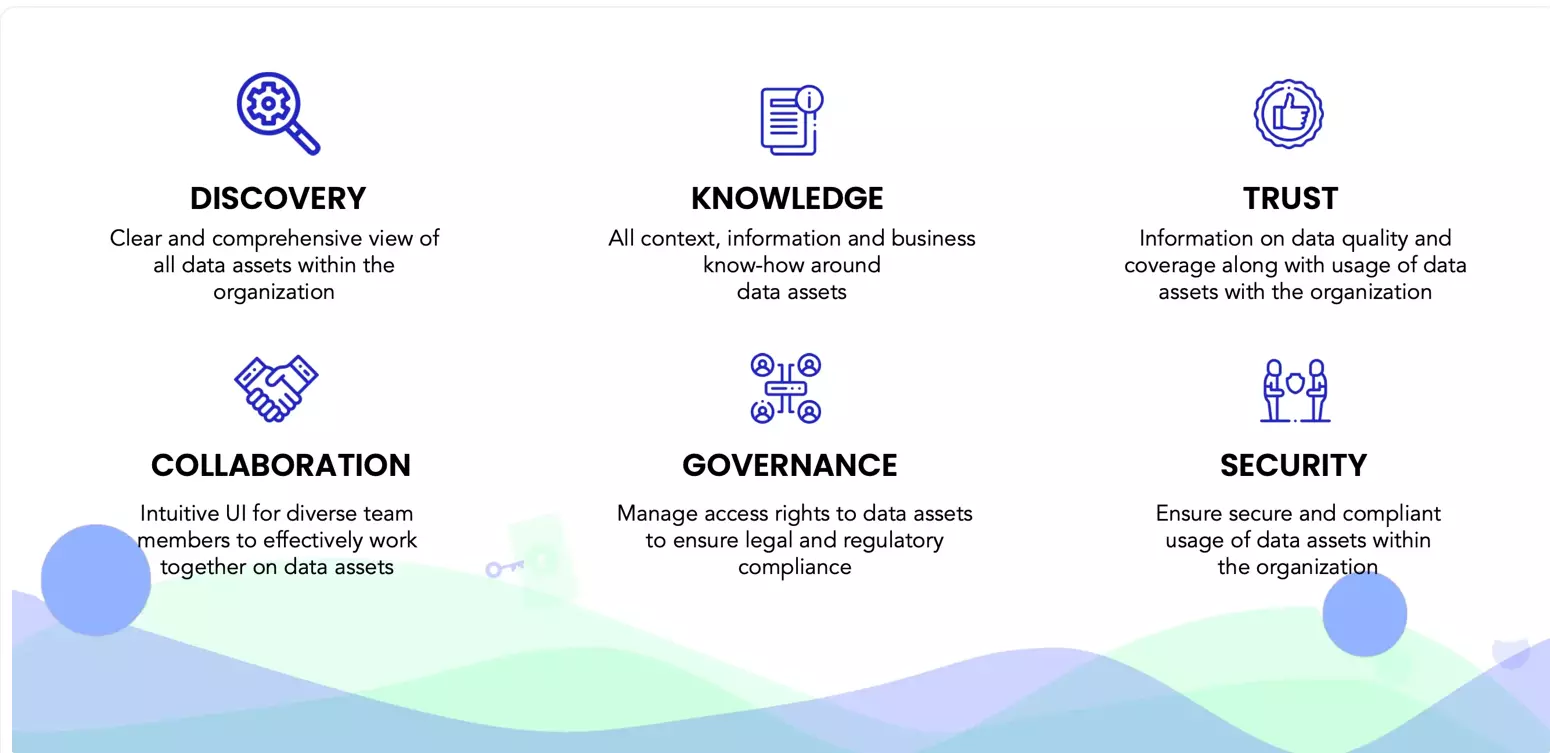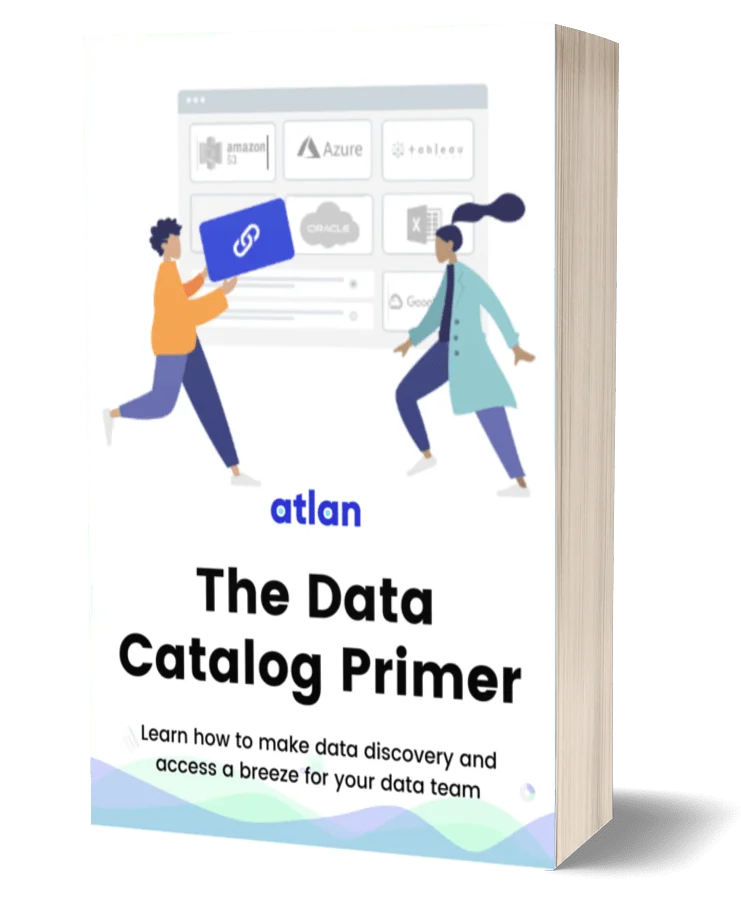10 Data Catalog Challenges and a Step-by-step Action Plan to Tackle Them

Share this article
While data catalogs are essential for enterprises to extract value from their data assets, the implementation can be daunting. Let’s explore the most vexing data catalog challenges and understand how to mitigate them with a 10-step action plan.
10 data catalog challenges to watch out for during implementation
Permalink to “10 data catalog challenges to watch out for during implementation”Several challenges can crop up when procuring, deploying, using, and maintaining a data catalog. These challenges include problems with:
- Data discovery and ingestion
- Data quality and accuracy
- Scalability and performance
- Data security and privacy
- User adoption and training
- Data governance and compliance
- Integration with other tools
- Vendor lock-in
- Maintenance and support
- Cost management
Let’s explore each data catalog challenge further
Table of contents
Permalink to “Table of contents”- 10 data catalog challenges to watch out for during implementation
- A 10-step action plan to mitigate data catalog challenges
- How to choose the right data catalog that takes care of the most common data catalog challenges
- Wrapping up
- Data catalog challenges: Related reads
1. Data discovery and ingestion
Permalink to “1. Data discovery and ingestion”Integrating various data sources into the catalog can be time-consuming and complex. You must ensure that the catalog can discover and ingest data from all relevant sources for your organization, including databases, data lakes, and third-party applications.
In addition to ingestion, data discovery is a significant challenge in data catalog projects. Making assets searchable isn’t enough, but leveraging metadata to map their relationships is essential.
Prukalpa Sankar, co-founder at Atlan, echoes this sentiment when she says that a fundamental data cataloging challenge isn’t the search algorithm:
“*The real challenge lies in building relevancy into data discovery — i.e. being able to curate and tag datasets and metadata so that we could build meaningful relationships between data assets and our search algorithms could understand what data was actually relevant to a user.*”
2. Data quality and accuracy
Permalink to “2. Data quality and accuracy”Ensuring that the information in the catalog is accurate and up-to-date is critical. This may require automating certain aspects of data validation processes and auto-updating metadata, schemas, and other data catalog components.
3. Scalability and performance
Permalink to “3. Scalability and performance”Despite the growing volume and complexity of your data, your data catalog should be able to scale operations. This requires automating several aspects of data and metadata management, such as identifying unused assets, accelerating metadata documentation, and propagating classifications across sensitive data assets.
4. Data security and privacy
Permalink to “4. Data security and privacy”Safeguarding sensitive data is essential to ensure data integrity and privacy, while complying with data protection laws and regulations. Your catalog should have robust security measures in place, such as data encryption, hashing and masking policies, access control, policy propagation via lineage, and auditing capabilities.
5. User adoption and training
Permalink to “5. User adoption and training”Your team must be comfortable using the data catalog, which may require training and ongoing support. Encourage adoption by choosing a catalog that integrates into your existing workflows and enables cross-team collaboration.
6. Data governance and compliance
Permalink to “6. Data governance and compliance”According to Lisa Ehrlinger, a Data Management and Data Quality Senior Researcher at Software Competence Center Hagenberg (SCCH):
“It is of utmost importance to build a comprehensive data governance strategy around the deployment of a data catalog to support organizations in finding and understanding all their data.”
Your catalog should support data governance policies and help maintain regulatory compliance. This may involve implementing processes for data lineage, data classification, and data retention.
7. Integration with other tools
Permalink to “7. Integration with other tools”Your data catalog should integrate well with your existing data ecosystem, including data analytics platforms, visualization tools, data storage solutions, and homegrown data products.
8. Vendor lock-in
Permalink to “8. Vendor lock-in”Be cautious of vendor lock-in when procuring a data catalog solution. Ensure that the chosen solution allows for flexibility, doesn’t come with archaic licensing fees, and can evolve with your organization’s needs.
The best way is to look for partners rather than vendors, offering solutions that are open by default and with a pay-as-you-go pricing.
9. Maintenance and support
Permalink to “9. Maintenance and support”A data catalog requires ongoing maintenance to ensure that it remains useful and relevant. This may involve updating metadata, fixing bugs, and enhancing functionality. Choose a solution provider that offers round-the-clock support to help address any issues that arise.
10. Cost management
Permalink to “10. Cost management”The costs of procuring, deploying, and maintaining a data catalog can be significant. Be sure to budget for these expenses and monitor them closely to ensure that you are receiving a good return on your investment.
By being aware of these challenges and proactively addressing them, you can help ensure the success of your data catalog implementation and maximize its benefits for your organization.
So, what’s the best way to deal with these data catalog challenges? We’ve put together an action plan to help you out.
A 10-step action plan to mitigate data catalog challenges and achieve your business outcomes
Permalink to “A 10-step action plan to mitigate data catalog challenges and achieve your business outcomes”Here’s an action plan to help you preempt and mitigate the above data catalog challenges:
- Define your goals and requirements and tie them to the right business outcomes
- Evaluate vendors and solutions in terms of factors, such as scalability, security, ease of use, integration with existing tools, and vendor support
- Develop a data governance framework with policies and guidelines for data management, including data quality, lineage, classification, and retention
- Plan for data discovery and ingestion and check how to automate the processes involved
- Ensure data security with the appropriate encryption, access control, and auditing measures
- Train your team and support them continuously so that they can integrate the catalog into their daily workflows
- Monitor and maintain data quality by reviewing and updating your data assets continuously
- Optimize performance and scalability of the data catalog so that it can accommodate future increases in data volume and complexity
- Establish a support structure with your solution provider to address any issues that arise during implementation and ongoing use of the data catalog
- Regularly assess the effectiveness of your data catalog in achieving your desired business outcomes by adjusting your strategies, processes, and tools
The next step is to pick the right data catalog. Read on to find out how to pick the right solution for your enterprise.
How to choose the right data catalog that takes care of the most common data catalog challenges
Permalink to “How to choose the right data catalog that takes care of the most common data catalog challenges”Here’s an evaluation framework to help you choose the right data catalog vendor, considering the data catalog challenges discussed earlier:
- Look at the solution fit
- Validate data quality and governance capabilities
- Review security and privacy measures
- Gauge usability and adoption
- Verify solution provider’s stability and support
- Evaluate the ROI
1. Look at the solution fit
Permalink to “1. Look at the solution fit”While there are several capabilities to look for, the data catalog should meet the following requirements:
- Data discovery and ingestion capabilities 👉 Assess the vendor’s ability to support various data sources and formats. Evaluate their tools and processes for discovering, cataloging, and ingesting data.
- Integration with existing tools 👉 Evaluate how well the solution integrates with your data universe, including analytics platforms, visualization tools, and storage systems.
- Scalability and performance 👉 Assess the solution’s ability to scale as your data volume and complexity grows. Investigate their track record in performance optimization and responsiveness.
Read more → 15 essential data catalog features in 2023
2. Validate data quality and governance capabilities
Permalink to “2. Validate data quality and governance capabilities”The two most important factors in data quality and governance are:
- Data validation and accuracy 👉 Evaluate the vendor’s data validation processes and mechanisms for ensuring data accuracy and up-to-date metadata.
- Data governance and compliance support 👉 Assess the solution’s ability to support data governance policies and maintain regulatory compliance. Also investigate features related to data lineage, classification, and retention.

Essential data cataloging capabilities to look for. Image by Atlan.
3. Review security and privacy measures
Permalink to “3. Review security and privacy measures”Evaluate the vendor’s data security measures, such as encryption, access control, and auditing capabilities.
Also assess whether the vendor complies with relevant data protection regulations and industry standards, such as GDPR, CCPA, and PCI DSS.
4. Gauge usability and adoption
Permalink to “4. Gauge usability and adoption”Test the solution’s user interface and determine if it is intuitive and easy to use for your team.
In addition, evaluate the vendor’s training resources, documentation, and customer support to help your team adopt and effectively use the data catalog.
5. Verify the solution provider’s stability and support
Permalink to “5. Verify the solution provider’s stability and support”Three essential factors that can help you verify the effectiveness of your data catalog solution provider are:
- Reputation and track record 👉 Investigate the solution provider’s reputation in the market and their experience in implementing data catalog solutions for other organizations. Check out some of their latest case studies to understand the problems they solve for their customers.
- Support and maintenance 👉 Assess the vendor’s support structure, including response times, SLAs, and the availability of dedicated resources to address any issues that arise.
- Product roadmap and innovation 👉 Evaluate the vendor’s product roadmap to ensure it aligns with your organization’s future needs and that they are committed to ongoing innovation.
6. Evaluate the ROI
Permalink to “6. Evaluate the ROI”To know whether the data catalog’s value justify its costs, you should:
- Compare the vendor’s pricing model with your budget and requirements by considering factors such as the number of users, data sources, and data volume
- Assess the costs associated with deploying, maintaining, and upgrading the solution, including any necessary hardware or software investments.
- Evaluate the potential ROI by considering factors such as improved efficiency, decision-making, and reduced data management costs.
Read more → Definition and evaluation guide for modern data catalogs
Wrapping up
Permalink to “Wrapping up”So far, we’ve discussed the most common data catalog challenges and set up an action plan to deal with those challenges.
By following the action plan and using the evaluation framework, you can proactively address potential data catalog challenges and get better value from your data assets.
Data catalog challenges: Related reads
Permalink to “Data catalog challenges: Related reads”- Enterprise data catalog: Definition, Importance & benefits
- Data Catalog: The Must-Have Tool for Data Leaders in 2023
- Data catalog benefits: 5 key reasons why you need one
- Open Source Data Catalog Software: 5 Popular Tools to Consider in 2023
- Data Catalog Platform: The Key To Future-Proofing Your Data Stack
- Top Data Catalog Use Cases Intrinsic to Data-Led Enterprises
- AWS Glue Data Catalog: Architecture, Components, and Crawlers
- Airbnb Data Catalog — Democratizing Data With Dataportal
- Lexikon: Spotify’s Efficient Solution For Data Discovery And What You Can Learn From It
- Google Cloud Data Catalog Guide - Everything You Need to Know
Share this article






















